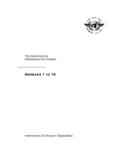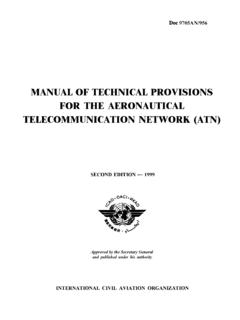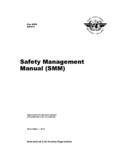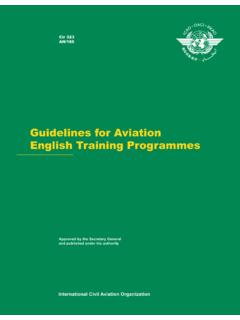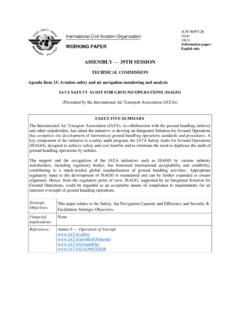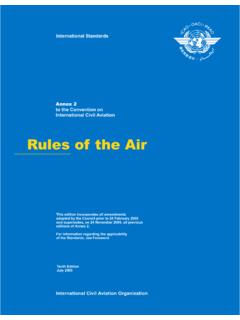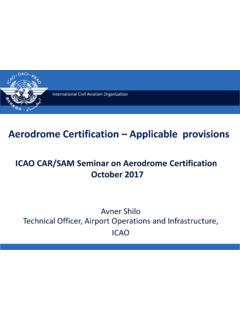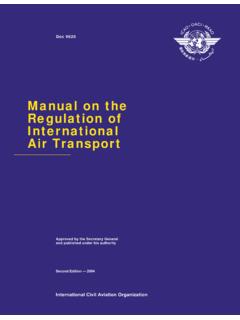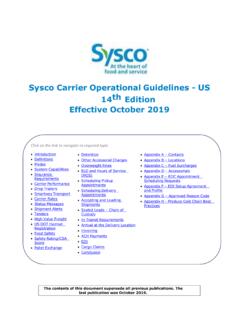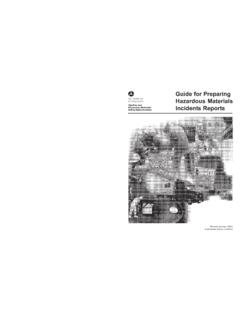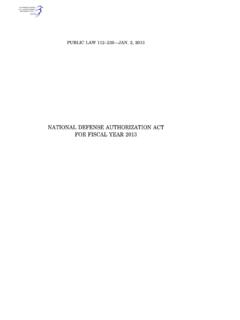Transcription of The Eco-Design of Airport Buildings - ICAO
1 2. The Eco-Design of Airport Buildings1. 1) Introduction .. 3. 2) Elements to consider when planning Eco-Design of Airport 5. 3) Sustainability Rating Systems and Airport Buildings .. 8. 4) 12. 1. The material in this document is provided as general information only and is not intended to provide specific legal advice for any individual and should not be relied upon in that regard. While every effort has been made to ensure the accuracy and veracity of the information in this document, ICAO is not responsible in any way for damages arising out of the use of these publications. And, although ICAO relies on reputable sources and believes the information contained in these documents is correct, and attempts to keep the information current, ICAO does not warrant the accuracy or completeness of the information. The designations employed and the presentation of material on any map and/or materials contained herein do not imply the expression of any opinion whatsoever on the part of ICAO.
2 Nothing herein shall constitute or be considered to be a limitation upon or a waiver of the privileges and immunities of ICAO. ICAO reserves the right to discontinue, change or modify this document at any time without notice. Links to other websites or references to other organizations, products, services or publications do not constitute endorsement or approval by ICAO. ICAO makes no representations whatsoever about any other references and websites that you may access through these publications. ICAO will not be liable for damages arising from, but in no way limited to, the use of the information provided in the e-publications. 2019. 3. 1) Introduction This e-publication is an overview of the environmental aspects related to Airport Buildings . Eco-Design of Airport Buildings refers to considerations of green Buildings and the environmental and resource-efficient operation and management of the Airport building from a life-cycle perspective.
3 This includes the overall process of Airport planning, design, construction, operation, maintenance, refurbishment, and demolition. Since the Airport is a complex hub for various facilities (shops, food outlets, air carrier operations) eco- design of Airport Buildings therefore entails complex collaboration among Airport stakeholders, with an overall aim to minimize impact to the natural environment and human health. Planning and designing an existing or new Airport building should take into consideration passenger and flight forecasts, since these Buildings are expected to last for decades and should accommodate the expected growth. Recently, due to climate change, another relevant aspect to consider is future climate conditions and the Airport Buildings '. resilience over the long term. When siting and designing aerodrome Buildings the safety and operational aspects are primary considerations.
4 This publication is focused on environmental aspects of the design, planning and construction of Airport Buildings . The International Civil Aviation Organization (ICAO) has specific standards and guidance material which deal with other aspects and they should be consulted accordingly. Additionally, Airport building design needs to consider the overall functionality of the Airport system. Overall Airport operations are dependent on aircraft connectivity and redundancy of systems. Terminal shape and layout should be designed to provide access for aircraft, and to facilitate the aircraft's access to taxiways and runways. However, there are many issues of environment and sustainability to consider when planning Airport Buildings . Airport sustainability combines economic, environmental, and social considerations into planning, design, construction, operations, and maintenance. The approach is often called EONS because it integrates economic considerations, operational efficiency, natural resources considerations, and social responsibility.
5 ACRP Synthesis 10, Airport Sustainability Practices includes a list of sustainability focus areas and corresponding practices. Resources for Airport Building Design There are many resources available on general Airport and terminal design, such as ICAO's Annex 14, Airport Planning Manual (Doc 9184), Airport Services Manual (Doc 9137)2, and Aerodrome Design Manual (Doc 9157). However, there are relatively few sources specific to environmental components of Airport Buildings . Guidance from the Federal Aviation Administration discusses the advantages of certain styles of concourses and gates in relation to runways and taxiways. Other sources focus on building materials and systems, such as: Airport Cooperative Research Program (ACRP) Report 25, Airport Passenger Terminal Planning and Design, Volumes 1 and 2;. International Air Transport Association (IATA) Airport Development Reference Manual.
6 ACRP Report 55, Passenger Level of Service and Spatial Planning for Airport Terminals; and ACRP Report 10, Innovations for Airport Terminal Facilities. Airport Buildings Airport Buildings take many forms, ranging from terminals for passenger use to hangars for aircraft to office space for administration. All can have an impact on the environment in their construction as well as 2. Airport Services Manual especially Part 9, and elements of Parts 6 and 1. 4. operational aspects. There are numerous environmental considerations with regard to building design and construction. For airports, there are also many operational elements that can be designed and managed to enhance the overall environmental performance of the facility. Buildings such as rental car facilities or hangars have specific functional considerations , aircraft maintenance that strongly influence their design and use. They are not designed so much for human occupancy as they are to accommodate specific processes.
7 Structures such as Airport passenger terminal facilities are primarily for public use, but also have some functional considerations as well. A terminal is meant to get flyers to their gate and onto the airplane, but must also accommodate traveler considerations such as ticketing/check-in, security, and baggage handling. Most passenger terminals provide services as well, such as restaurants and shopping. These Buildings have some flexibility in their design and layout, but must satisfy the traveler requirements and have considerations such as accommodating layover times for large volumes of people. The design and use of space at an Airport is both an art and a science. Every Airport is distinct, and there is no one size fits all' solution to Eco-Design of Airport Buildings . In addition, the layout and use of space are interconnected concepts. It is equally as important to look at the overall Airport layout for Eco-Design '.
8 Elements as it is to focus on the structures themselves. This publication will stay limited, however, to some of the basic environmental considerations that should accompany Airport building development, management, and modification. Considering the environment and minimizing environmental impacts can be worked into Airport Buildings at many levels. Terminals Terminal planning and design often begins with a planning process to identify the constraints of the existing terminal and set priorities for the new terminal project. A good assessment will answer questions about expected passenger volumes, needs of the tenants and concessions, and other expectations that will drive the design or renovation of a facility. Environmental objectives should also be added to the planning process. The terminal is generally the biggest and most complex facility at an Airport , with the most energy needs. Airport planners and environmental analysts should identify environmental issues for the proposed terminal project so they can be included in the project scope and budget.
9 Likewise, the new structure may require an environmental impact assessment of some kind. Other facilities There are other facilities at the airports, other than the terminals, where Eco-Design considerations may be incorporated. Buildings in the Airport landside such as cargo facilities and parking facilities may be areas where sustainability consideration can be applied. On the other hand, for some facilities, especially on the airside of the Airport , there are safety and operational guidelines that the design should adhere to, for example reliable energy supply to air navigation equipment. For those cases, such regulation may not allow much room for environmental consideration. This document will mainly address the Eco-Design of terminal Buildings , as that is where there is the most opportunity to use good design principles to reduce environmental impacts. Nevertheless, the same considerations may be applied to other facilities in the Airport .
10 Some Buildings on which Eco-Design could be used for both construction and operations to improve environmental performance may include, inter alia: Cargo terminal Buildings and warehouses Air traffic control towers and back-up air traffic control centers Hangars and maintenance facilities Parking structures Offices Buildings Fuel farms 5. Fire stations and fire training areas 2) Elements to consider when planning Eco-Design of Airport Buildings Integrated systems An Airport terminal brings many functions into one place. A modern passenger terminal facility is a combination of numerous systems such as lighting, temperature control, and waste management that are integrated into a physical shelter to make it comfortable for human activities. Besides these basics, any proposed Airport development should be safe and efficient, it should be reasonable for the size of the Airport , and it must meet any national Airport design standards.

